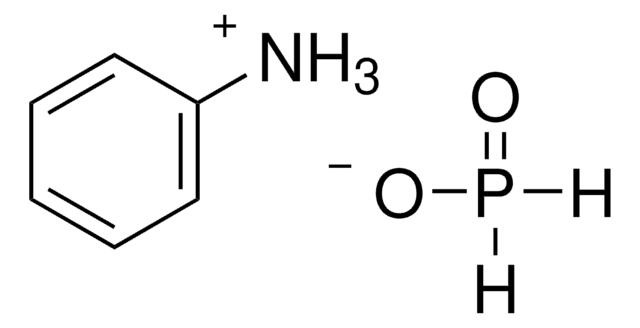214906
Hypophosphorous acid solution
50 wt. % in H2O
Synonyme(s) :
Phosphinic acid
About This Item
Produits recommandés
Pression de vapeur
<17 mmHg ( 20 °C)
Niveau de qualité
Forme
liquid
Concentration
48-52% in NaOH (titration)
50 wt. % in H2O
pH
1 (20 °C, 500 g/L)
Densité
1.206 g/mL at 25 °C
Chaîne SMILES
O[PH2]=O
InChI
1S/H3O2P/c1-3-2/h3H2,(H,1,2)
Clé InChI
ACVYVLVWPXVTIT-UHFFFAOYSA-N
Vous recherchez des produits similaires ? Visite Guide de comparaison des produits
Catégories apparentées
Description générale
It undergoes oxidation in the presence of Ce(IV) and a strong acid to afford cerium(IV) hypophosphite complex ions.
Application
- Synthesis of Aminobisphosphinates through a Cascade Reaction between Hypophosphorous Acid and Bis(trimethylsilyl)imidates Mediated by ZnI(2).: This research presents a novel method for synthesizing aminobisphosphinates, utilizing hypophosphorous acid in a zinc iodide-mediated cascade reaction, which could be relevant in the development of new chemical entities in medicinal chemistry (Ayadi et al., 2023).
- Facile Synthesis of Liquid Crystal Dimers Bridged with a Phosphonic Group.: This study explores the use of hypophosphorous acid in the synthesis of phosphonic group-bridged liquid crystal dimers, offering potential advancements in materials science and display technologies (Wang et al., 2022).
- Oxidation of Hypophosphorous Acid by a Ruthenium(VI) Nitrido Complex in Aqueous Acidic Solution. Evidence for a Proton-Coupled N-Atom Transfer Mechanism.: Investigates the mechanistic details of hypophosphorous acid oxidation by a ruthenium complex, shedding light on reaction pathways important in catalysis and synthesis (Li et al., 2022).
- Solution-processed Ge(ii)-based chalcogenide thin films with tunable bandgaps for photovoltaics.: Discusses the application of hypophosphorous acid in the development of germanium-based chalcogenide thin films, contributing to advancements in photovoltaic materials (Hu et al., 2022).
- One-Pot Synthesis and in Silico Molecular Docking Studies of Arylselanyl Hydrazides as Potential Antituberculosis Agents.: Utilizes hypophosphorous acid in the one-pot synthesis of arylselanyl hydrazides, evaluated for their potential as antituberculosis agents through molecular docking studies (Borges et al., 2022).
Mention d'avertissement
Danger
Mentions de danger
Classification des risques
Eye Dam. 1 - Met. Corr. 1 - Skin Corr. 1B
Code de la classe de stockage
8B - Non-combustible corrosive hazardous materials
Classe de danger pour l'eau (WGK)
WGK 1
Point d'éclair (°F)
Not applicable
Point d'éclair (°C)
Not applicable
Certificats d'analyse (COA)
Recherchez un Certificats d'analyse (COA) en saisissant le numéro de lot du produit. Les numéros de lot figurent sur l'étiquette du produit après les mots "Lot" ou "Batch".
Déjà en possession de ce produit ?
Retrouvez la documentation relative aux produits que vous avez récemment achetés dans la Bibliothèque de documents.
Les clients ont également consulté
Notre équipe de scientifiques dispose d'une expérience dans tous les secteurs de la recherche, notamment en sciences de la vie, science des matériaux, synthèse chimique, chromatographie, analyse et dans de nombreux autres domaines..
Contacter notre Service technique















